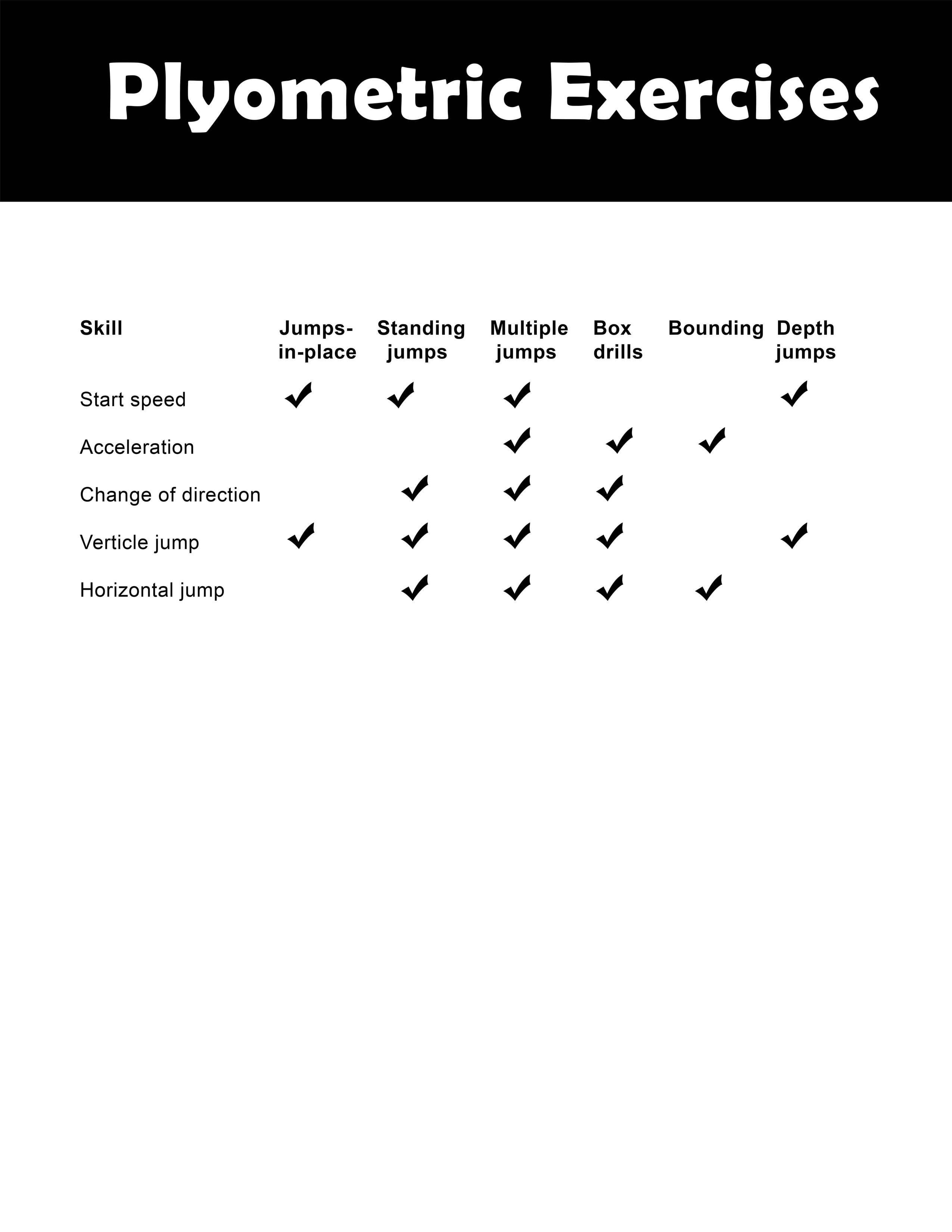 Plyometrics exercises for your entire body.
Plyometrics exercises for your entire body.
Multiple hops and jumps combine the skills developed by jumps-in-place and standing jumps. They require maximal effort but are done one after another. These exercises can be done alone or with a barrier. An advanced form of multiple hops and jumps is the box drill. Multiple hops and jumps should be done for distances of less than 30 meters.
Download medium plyometric exercise poster (17" by 11")
Two-Foot Ankle Hop
Equipment
None
Start
Stand with feet shoulder-width apart and the body in a vertical position.
Action
Using only the ankles for momentum, hop continuously in one place. Extend the ankles to their maximum range on each vertical hop.
Single foot side-to side ankle hop
Equipment
Two cones placed three to four feet apart.
Start
Stand on one foot between the cones.
Action
Hopping from one foot to the other, land on the right foot next to the right cone, then the left foot next to the left cone. Continue hopping back and forth.
Side-to-side Ankle hop
Equipment
No equipment is required, but cones may be used as borders.
Start
Stand with feet shoulder-width apart and the body in a vertical position.
Action
Using both feet jump side to side, covering a span of two to three feet; produce the motion from the ankles. Keep the feet shoulder-width apart and land on both feet at the same time.
Hip-Twist Ankle Hop
Equipment
None
Start
Stand with feet shoulder-width apart and the upper body in a vertical position.
Action
Hop up and twist from the hips, turning the legs in a 180-degree arc. On the next hop, turn the legs to return to the starting position. Continue turning the legs form side to side on each hop. The upper body does not turn; the movement comes from the hips and legs.
There are no articles in this category. If subcategories display on this page, they may have articles.
Subcategories
Upper Body Plyometrics
Lower Body Plyometrics
Plyometrics Jumps
Plyometrics Bounding
Bounding exercises exaggerate normal running stride to stress a specific aspect of the stride cycle. They are used to improve stride length and frequency, and typically are performed for distances greater than 30 meters.
Plyometrics Hops
Plyometrics Leaps Exercises
Plyometric leaps exercises emphasizes maximum height and horizontal distance.
Depth jumps use the athlete’s body weight and gravity to exert force against the ground. Depth jumps are performed by stepping out from a box and dropping to the ground, then attempting to jump back up to the height of the box. Because depth jumps are of a prescribed intensity, one should neverjump from the top of the box as this adds height ad increases the landing stress. Rather, one should attempt to step out into space before dropping to the ground Cotrolling the height dropped helps not only to accurately measure intensity but also to reduce overuse problems. Upon making contact with the ground, athlete directs the body up as fast as possible, the key to performing this exercise and decreasing the amortization phase is to stress the “touch and go” action off the ground.
Researchers from the soviet union have shown that depth jumps were an effective means of increasing athletes’ speed and strength capabilities.
Determining maximum dept jump height
1. the athlete is measured as accurately as possible for a standing jump-and-reach
2. The athlete performs a depth jump from an 18-inch box height, trying to attain the same jump-and-reach score.
3. If the athlete successfully executes this task, he or she may move to a higher box. The box height should be increased in 6-inch increments. Step 2 is repeated until the athlete fails to reach the standing jump-and-reach height. This then becomes the athlete’s maximum height for dept jumps.
4. If the athlete cannot reach the standing jump-and-reach height form an 18-inch box, either the height of the box should be lowered or depth jumping abandoned for a time in favor of strength development. If the athlete cannot rebound from a basic height of 18 inches he or she probably does not have the musculoskeletal readiness for depth jumping.

